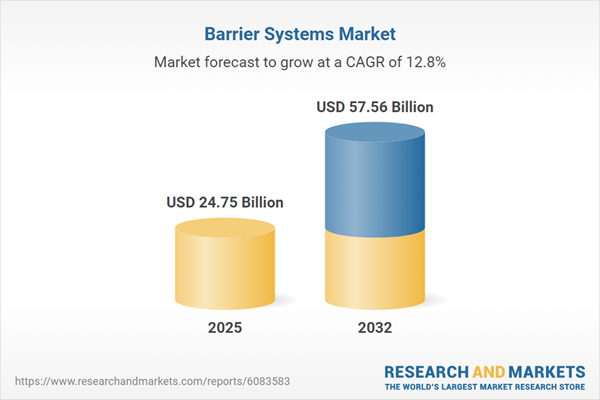Speak directly to the analyst to clarify any post sales queries you may have.
The barrier systems market is undergoing significant transformation as organizations prioritize advanced security, traffic regulation, and compliance. Senior leaders are increasingly focused on resilient solutions that offer adaptability and seamless integration within critical infrastructure environments.
Market Snapshot: Barrier Systems Market Size, Growth, and Outlook
The barrier systems market grew from USD 21.91 billion in 2024 to USD 24.75 billion in 2025 and is forecast to achieve a compound annual growth rate (CAGR) of 12.83%, reaching USD 57.56 billion by 2032.
This expansion reflects greater sector demand driven by heightened security standards, increased traffic, and advancement of technology-based solutions. Adoption is accelerating as public and private organizations bring barrier system installations to the forefront of their operational strategies, with next-generation systems increasingly regarded as vital for risk control and regulatory alignment in both developing and mature markets worldwide.Scope & Segmentation of the Barrier Systems Market
This report delivers in-depth analysis of the barrier systems market, equipping decision-makers with relevant insights for procurement, implementation, and strategic planning. Segmentation highlights include:
- Product Types: Crash-rated bollards for high-security applications; fixed and removable bollards offering flexible access control; rising arm barriers and sliding gates for efficient vehicle flow; wedge barriers for critical blocking requirements.
- Operation Modes: Automatic options tailored for busy or sensitive sites; manual solutions supporting legacy infrastructure or budget limitations; semi-automatic systems optimizing operational flexibility.
- End Users: Security and management solutions for commercial properties, government assets, industrial zones, residential communities, and major transportation routes.
- Geographic Regions: Robust activity spans the Americas—including the United States, Canada, and Brazil—Europe, the Middle East and Africa, and Asia-Pacific, encompassing both rapidly growing and mature economies.
- Leading Market Participants: Major companies such as Delta Scientific Corporation, Automatic Systems SA, Boon Edam Inc., Gunnebo AB, and FAAC Group S.p.A. deliver portfolios tailored to varying operational challenges and security requirements.
- Core Technologies: Integration of smart sensors, analytics powered by artificial intelligence, and remote monitoring infrastructure enables real-time response, system alerts, and predictive maintenance capabilities within mission-critical environments.
Key Takeaways: Strategic Insights for Decision-Makers
- Barrier systems have become foundational for perimeter management, enabling organizations to coordinate routine access while swiftly responding to threats across diverse facility types.
- The evolution towards digital intelligence—incorporating features like predictive analytics and remote diagnostics—optimizes maintenance schedules and enhances operational reliability.
- Changes in compliance and regulatory requirements are prompting R&D into eco-friendly materials and safety-driven product innovations.
- Providers leverage diversified models for both products and operations, supporting modular deployment as well as fully integrated security infrastructures, tailored to sector-specific needs.
- Collaboration across manufacturers and technology partners accelerates the development of unified systems that can address and adapt to emerging security risks.
- Enhanced supply chain management, through regional alliances and streamlined logistics, increases resilience and supports consistent delivery amid evolving global market conditions.
Tariff Impact on Supply Chains and Operations
Recently introduced US tariffs in 2025 resulted in higher costs for essential barrier system materials, including raw steel and electronic components. Leading manufacturers adapted by revising sourcing practices, boosting local production capacity, and optimizing logistics to safeguard pricing structures and maintain a competitive edge. This has enabled the market to stay agile and fostered the use of advanced materials and more efficient assembly methods, supporting steady industry performance during periods of policy fluctuation.
Methodology & Data Sources
This analysis utilizes a combination of primary data from stakeholder interviews and expert panels, together with secondary research from technical literature and regulatory sources. Data integrity is validated using triangulation and peer review to ensure accurate, impartial market intelligence.
Why This Report Matters
- Empowers executive and procurement teams with actionable market intelligence for timely investment, vendor relationships, and risk mitigation in commercial, government, and industrial settings.
- Enables leadership to benchmark organizational positioning against competitors, track technology adoption, and anticipate compliance trends shaping future strategies.
- Offers clear frameworks for managing supply disruptions and identifying growth opportunities with agile, informed decision-making.
Conclusion
Barrier systems are advancing as intelligent infrastructure assets, deeply integrated into security ecosystems. Aligning procurement strategies with innovation and regulatory change positions organizations to achieve sustained operational success in an evolving risk environment.
Table of Contents
3. Executive Summary
4. Market Overview
7. Cumulative Impact of Artificial Intelligence 2025
Companies Mentioned
The companies profiled in this Barrier Systems market report include:- Delta Scientific Corporation
- Automatic Systems SA
- Boon Edam Inc.
- Gunnebo AB
- FAAC Group S.p.A.
- CAME S.p.A.
- Betafence International BV
- HESCO Bastion Ltd
- Perimeter Protection International Ltd
- Magnetic Autocontrol GmbH
Table Information
| Report Attribute | Details |
|---|---|
| No. of Pages | 192 |
| Published | November 2025 |
| Forecast Period | 2025 - 2032 |
| Estimated Market Value ( USD | $ 24.75 Billion |
| Forecasted Market Value ( USD | $ 57.56 Billion |
| Compound Annual Growth Rate | 12.8% |
| Regions Covered | Global |
| No. of Companies Mentioned | 11 |









